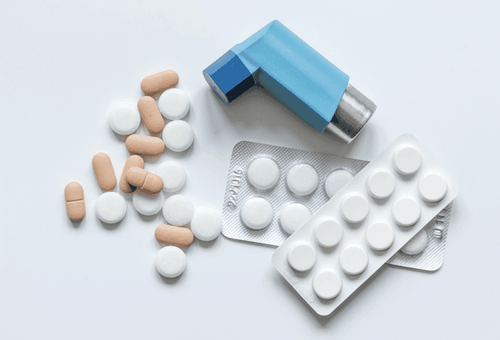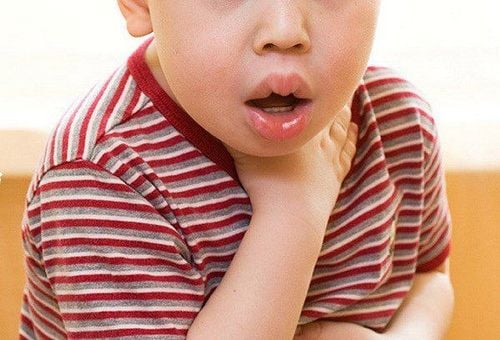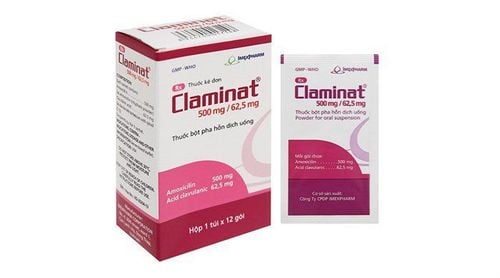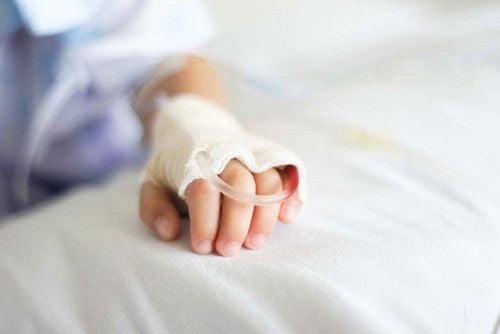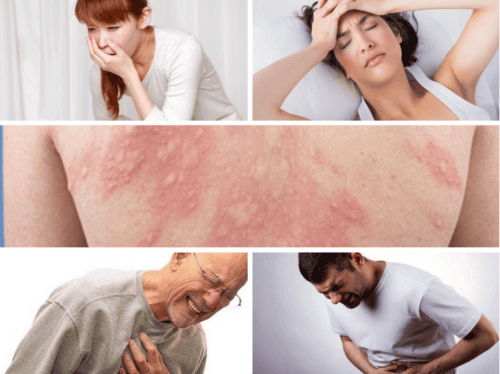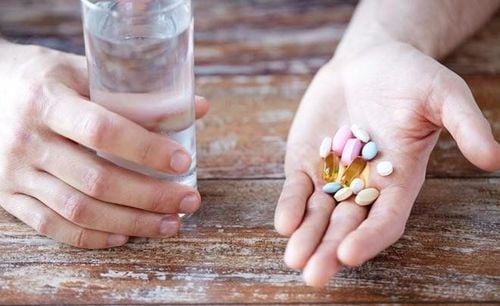This is an automatically translated article.
Posted by Doctor Le Van Binh Department of Intensive Care - Vinmec Times City International General Hospital
Anaphylaxis in children is an extremely dangerous phenomenon, requiring prompt emergency care to prevent potentially life-threatening complications. Anaphylaxis in children is the most severe form of anaphylaxis due to sudden systemic vasodilatation and bronchospasm that can be fatal within minutes.
1. What is anaphylaxis in children?
Anaphylaxis in children is an allergic reaction, which can appear immediately from a few seconds, minutes to several hours after a child's body is exposed to a potentially allergenic allergen. mild to severe symptoms or rapid death.
Anaphylaxis in children is the most severe form of anaphylaxis due to sudden dilation of the entire vasculature and bronchospasm that can be fatal within minutes.

Sốc phản vệ có thể gây tử vong nhanh chóng
2. Diagnosis of anaphylaxis in children
2.1. Suggested symptoms Parents need to be alert when their child has the following signs of anaphylaxis:
Urticaria, rapid angioedema Shortness of breath, chest tightness, stridor Abdominal pain or vomiting Low blood pressure or fainting Consciousness 2.2. Clinical situations Clinical picture 1: Symptoms appear within seconds to several hours in the skin and mucous membranes (urticaria, angioedema, pruritus...) and have at least 1 of the following 2 symptoms: respiratory symptoms Hypotension (BP) or consequences of hypotension (disordered consciousness, defecation, urinary incontinence...). Clinical picture 2: At least 2 out of 4 symptoms of anaphylaxis in children appear within seconds to hours after exposure to the suspected element, including: Mucosal and skin manifestations: Angioedema, itching , urticaria Respiratory symptoms such as: stridor, dyspnea, rales Low blood pressure or consequences of hypotension (disorders of consciousness, defecation, urinary incontinence...) . Gastrointestinal symptoms (vomiting, abdominal pain...). Clinical scenario 3: The child has a drop in blood pressure, this sign may appear within seconds to hours after the child is exposed to the suspect factor: Children: at least 30% decrease in systolic blood pressure (BP). maximal) or a drop in systolic blood pressure for age (systolic blood pressure <70 mmHg).
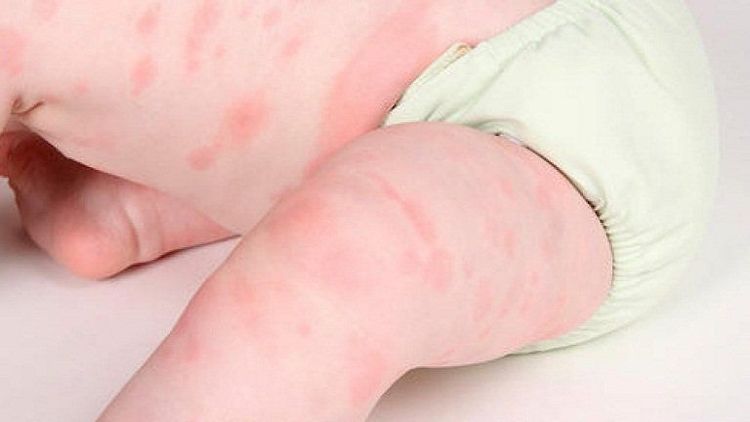
Trẻ phù mạch nổi mề đay cũng là một trong những triệu chứng của phản vệ
2.3. Differential diagnosis: Shock cases: hypovolemic shock, cardiogenic shock, septic shock Respiratory causes: Bronchial asthma attack, laryngeal dyspnea (due to foreign body, inflammation). Skin diseases such as angioedema, urticaria Endocrine diseases such as: carcinoid syndrome, thyroid storm, hypoglycemia... Poisonings: opiates, histamine. 2.4. Diagnosis level: Anaphylaxis in children is classified into 4 levels as follows:
Mild (Grade I): Only symptoms appear on the skin, subcutaneous tissues and mucous membranes such as itching, angioedema, urticaria. Severe (grade II): The body appears from 2 manifestations in many organs of the body. Urticaria, angioedema appear quickly Shortness of breath fast shallow, chest tightness, hoarseness, runny nose Abdominal pain, vomiting, diarrhea... Tachycardia or arrhythmia, blood pressure has not dropped or increased Critical (grade III) ) : At this level, anaphylaxis in children has manifestations in many organs with more severe severity, specifically: Airway manifestations: laryngeal edema, laryngeal stridor Airway: Wheezing, breathing rapid, cyanotic or irregular breathing Consciousness: Convulsions, confusion, coma, circular muscle disturbances Circulatory: Small tachycardia, shock, hypotension Circulatory arrest (grade IV): Child has symptoms circulatory arrest, respiratory arrest.

Huyết áp trẻ giảm nhanh khi phản vệ ở mức độ nguy kịch
3. Guidelines for emergency treatment of anaphylaxis in children
3.1. General principles All cases of anaphylaxis in children need to be detected early and treated urgently and promptly on the spot, children need to be monitored continuously within 24 hours. As soon as a child shows signs of anaphylaxis, medical staff must first treat anaphylaxis. Adrenalin is an essential drug and plays a leading role in saving the life of patients with anaphylaxis. Adrenalin must be injected intramuscularly as soon as the patient's anaphylaxis grade II or higher is diagnosed. 3.2. Treatment of mild anaphylaxis (grade I): Allergic but can become severe or critical:
Stop exposure to the drug or the allergen (if any) Use diphenhydramine or methylprednisolone depending on the situation patient. Continue to monitor patients with anaphylaxis for at least 24 hours for timely treatment. 3.3. Emergency treatment regimen for severe and critical anaphylaxis (Grade II, III) In fact, Grade II anaphylaxis can quickly turn to Grade III and IV, so it is necessary to urgently deal with it. Simultaneously according to disease progression:
Stop exposure to drugs or allergens that cause anaphylaxis (if any). Administer adrenaline injection or infusion (see section 4 below). Put the patient in a lying position, with the head low, if vomiting, turn left. Oxygen: children 2-41/min through an open mask. Assess the patient's circulatory, respiratory, consciousness and mucosal and skin manifestations. Balloon compression and Cardiac compression outside the chest (if the patient stops breathing, circulation). Emergency tracheostomy or Intubation (if patient has laryngeal dyspnea). Place an intravenous catheter and a second IV line or establish an intravenous adrenaline line with a conventional line but a large needle (size 14 or 16G) for rapid infusion. Report to superiors and consult with emergency, resuscitation and/or allergist (if any).
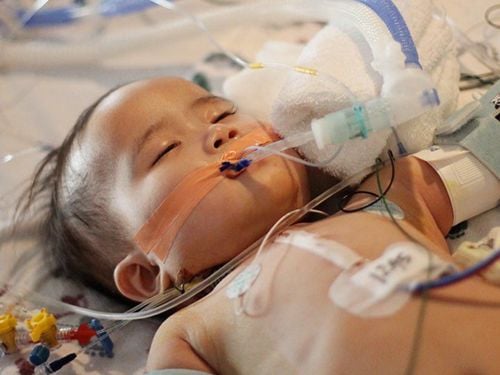
Đặt ống nội khí quản đảm bảo đường thở cho trẻ
3.4. Regimen using adrenaline and infusion Objectives: Raise and maintain stable maximum BP of children ≥ 70mmHg and no longer have respiratory signs such as stridor, dyspnea; digestive symptoms.
Intramuscular adrenaline: 1mg = 1ml = 1 tube:
For infants or children <10kg: 0.2ml (equivalent to 1/5 ampoules). For children about 10 kg: 0.25ml (equivalent to 1/4 tube). For children about 20 kg: 0.3ml (equivalent to 1/3 tube). For children > 30kg: 0.5ml (equivalent to 1/2 tube). Monitor blood pressure every 3-5 minutes. Repeat injection of adrenaline at the same dose every 3-5 minutes until blood pressure and pulse stabilize. If pulse is not detected and blood pressure is not measured, respiratory and gastrointestinal symptoms worsen after 2-3 intramuscular injections as described in 4.1, section 4, or there is a risk of circulatory arrest, continuous intravenous infusion of adrenaline should be considered when The infusion line was established (adrenaline mixed with 0.9% sodium chloride solution). Start with a dose of 0.1 μg/kg/min, then adjust the adrenaline dose every 3-5 minutes according to the patient's response. Concomitantly with continuous intravenous adrenaline, a rapid infusion of 0.9% sodium chloride solution 10-20ml/kg over 10-20 minutes may be repeated if necessary. When there is an intravenous line of adrenaline with a dose to maintain stable blood pressure, the patient's pulse and blood pressure can be monitored every 1 hour to 24 hours.
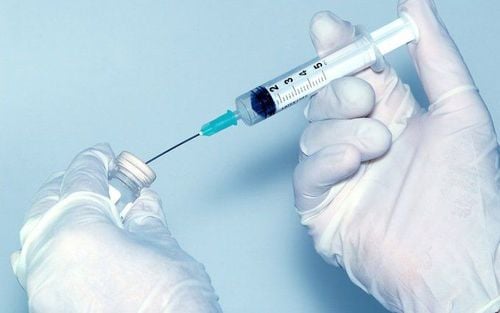
Tiêm adrenalin để nâng và duy trì ổn định HA tối đa của trẻ
3.5. Follow-up treatment Support for circulation and respiration: Depending on the degree of respiratory and circulatory failure in the patient, one or the following measures can be used: Breathing oxygen through a mask: 2-4 liters/minute in Children Squeeze the AMBU balloon with oxygen Intubate artificially ventilate with oxygen if the patient's stridor increases and does not respond to adrenaline If there is glottis-hypopharyngeal edema and cannot intubate, perform a tracheostomy Administer slow intravenous infusion: salbutamol 0.1 μg/kg/min or terbutaline 0.1 μg/kg/min or aminophyllin 1 mg/kg/hour (preferably via an electric syringe or infusion machine) May replace aminophyllin by salbutamol 2.5mg nebulized through a mask or by mouth spray salbutamol 100μg 2 puffs/time, 4-6 times a day. In the event that the patient's blood pressure cannot be raised to target after adequate fluid and adrenaline infusion, colloidal solutions can be infused. Other drugs: Methylprednisolone 1-2mg/kg/time (maximum 50mg in children) intravenously H1 antihistamines such as diphenhydramine intramuscular or intravenous: 10-25mg children. Antihistamine H2 such as ranitidine: children 1mg/kg mixed in 20ml Dextrose 5% intravenously over 5 minutes. Glucagon: In cases of bradycardia, hypotension unresponsive to adrenaline. Dosage: children 20-30μg/kg, maximum 1mg, then maintain intravenous infusion of 5-15μg/minute depending on clinical response. It is possible to add other vasopressors such as dobutamine, dopamine, noradrenalin intravenously when the patient with severe shock has been given enough fluids and adrenaline but the blood pressure does not rise. 3.6. Monitoring During the acute phase: Monitor pulse, SpO2, blood pressure, breathing rate and consciousness every 3-5 minutes until stable. In the stable phase: Monitor the patient's pulse, blood pressure, SpO2, breathing rate and consciousness every 1-2 hours for at least the next 24 hours. Patients need to be monitored at medical facilities for at least 24 hours after their blood pressure has stabilized and to prevent phase 2 anaphylaxis. In case after emergency treatment stops the active circulation without results, stop the emergency. . Above is some information about anaphylaxis in children. Please follow the website: Vinmec.com regularly to update many other useful information.





